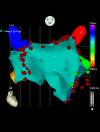Short- and long-term experience in pulmonary vein segmental ostial ablation for paroxysmal atrial fibrillation
- PMID: 16943889
- PMCID: PMC1501090
Short- and long-term experience in pulmonary vein segmental ostial ablation for paroxysmal atrial fibrillation
Abstract
Introduction: Segmental ostial pulmonary vein isolation (PVI) is considered a potentially curative therapeutic approach in the treatment of paroxysmal atrial fibrillation (PAF). There is only limited data available on the long-term effect of this procedure.
Methods: Patients (Pts) underwent a regular clinical follow up visit at 3, 6 and 24 months after PVI. Clinical success was classified as complete (i.e. no arrhythmia recurrences, no antiarrhythmic drug), partial (i.e. no/only few recurrences, on drug) or as a failure (no benefit). The clinical responder rate (CRR) was determined by combining complete and partial success.
Results: 117 patients (96 male, 21 female), aged 51+/-11 years (range 25 to 73) underwent a total of 166 procedures (1.4/patient) in 2-4 pulmonary veins (PV). 115 patients (98%) had AF, 2 patients presented with regular PV atrial tachycardia. ,109/115 patients. exhibited PAF as the primary arrhythmia (versus persistent AF). A total of 113 patients with PVI in the years 2001 to 2003 were evaluated for their CRR after 6 (3) months. A single intervention was carried out in 63 patients (55.8%), two interventions were performed in 45 patients (39.8%) and three interventions in 5 patients (4.4%). The clinical response demonstrated a complete success of 52% (59 patients), a partial success of 26% (29 patients) and a failure rate of 22% (25 patients), leading to a CRR of 78% (88 patients). Ostial PVI in all 4 PVs exhibited a tendency towards higher curative success rates (54% versus 44% in patients with 3 PVs ablated for the 6 month follow up). Long-term clinical outcome was evaluated in 39 patients with an ablation attempt at 3 PVs only (excluding the right inferior PV in our early experience) and a mean clinical follow up of 21+/-6 months. At this point in time the success rate was 41% (complete, 16 patients) and 21% (partial, 8 patients), respectively, adding up to a CRR of 62% (24 patients). In total, 20 patients (17.1%) had either a single or 2 (3 patients, 2.6%) complications independent of the number of procedures performed with PV stenosis as the leading cause (7.7%).
Conclusion: The CRR of patients with medical refractory PAF in our patient cohort is 78% at the 6 month follow up. PV stenosis is the main cause for procedure-related complications. Ablation of all 4 PV exhibits a tendency towards higher complete success rates despite equal CRR. Calculation of the clinical response after a mid- to long-term follow of 21+/-6 months in those patients with an ostial PVI in only 3 pulmonary veins (sparing the right inferior PV) shows a further reduction to 62%, exclusively caused by a drop in patients with a former partial success. To evaluate the long-term clinical benefit of segmental ostial PVI in comparison with other ablation techniques, more extended follow up periods are mandatory, including a larger study cohort and a detailed description of procedural parameters.
Figures







Similar articles
-
Intermediate term outcome after electrogram guided segmental ostial pulmonary vein isolation using an 8 mm tip catheter for paroxysmal atrial fibrillation.Indian Heart J. 2019 Sep-Oct;71(5):381-386. doi: 10.1016/j.ihj.2019.11.258. Epub 2019 Dec 6. Indian Heart J. 2019. PMID: 32035520 Free PMC article.
-
Recurrence of pulmonary vein conduction and atrial fibrillation after pulmonary vein isolation for atrial fibrillation: a randomized trial of the ostial versus the extraostial ablation strategy.Am Heart J. 2006 Sep;152(3):537.e1-8. doi: 10.1016/j.ahj.2006.05.029. Am Heart J. 2006. PMID: 16923426 Clinical Trial.
-
Segmental pulmonary vein ablation: success rates with and without exclusion of areas adjacent to the esophagus.Pacing Clin Electrophysiol. 2008 Jun;31(6):652-9. doi: 10.1111/j.1540-8159.2008.01067.x. Pacing Clin Electrophysiol. 2008. PMID: 18507536 Clinical Trial.
-
[Interventional therapy of atrial fibrillation: possibilities and limitations].Dtsch Med Wochenschr. 2010 Mar;135 Suppl 2:S48-54. doi: 10.1055/s-0030-1249209. Epub 2010 Mar 10. Dtsch Med Wochenschr. 2010. PMID: 20221979 Review. German.
-
Catheter Ablation of Paroxysmal Atrial Fibrillation: Have We Achieved Cure with Pulmonary Vein Isolation?Methodist Debakey Cardiovasc J. 2015 Apr-Jun;11(2):71-5. doi: 10.14797/mdcj-11-2-71. Methodist Debakey Cardiovasc J. 2015. PMID: 26306122 Free PMC article. Review.
References
-
- Haissaguerre M, Jais P, Shah DC, et al. Spontaneous initiation of atrial fibrillation by ectopic beats originating in the pulmonaty veins. N Engl J Med. 1998;339:659–666. - PubMed
-
- Haissaguerre M, Shah DC, Jais P. Electrophysiological breakthroughs from the left atrium to the pulmonary veins. Circulation. 2000;102:2463–2465. - PubMed
-
- Karch MR, Zrenner B, Deisenhofer I. Freedom from atrial tachyarrhythmias after catheter ablation of atrial fibrillation. A randomized comparison between 2 current ablations strategies. Circulation research. 2005;111:2875–2880. - PubMed
-
- Pappone C, Rosanio S, Augello G, et al. Mortality, morbidity, and quality of life after circumferential pulmonary vein ablation for atrial fibrillation: outcomes from a controlled non-randomized long-term study. J Am Coll Cardiol. 2003;42:185–197. - PubMed
-
- Pürerfellner H, Aichinger J, Nesser HJ, et al. Segmentale ostiale Katheterablation der Pulmonalvenen bei paroxysmalem Vorhofflimmern: Ergebnisse nach einjähriger Erfahrung. J Kardiol. 2002;9:497–505.
LinkOut - more resources
Full Text Sources
Research Materials
